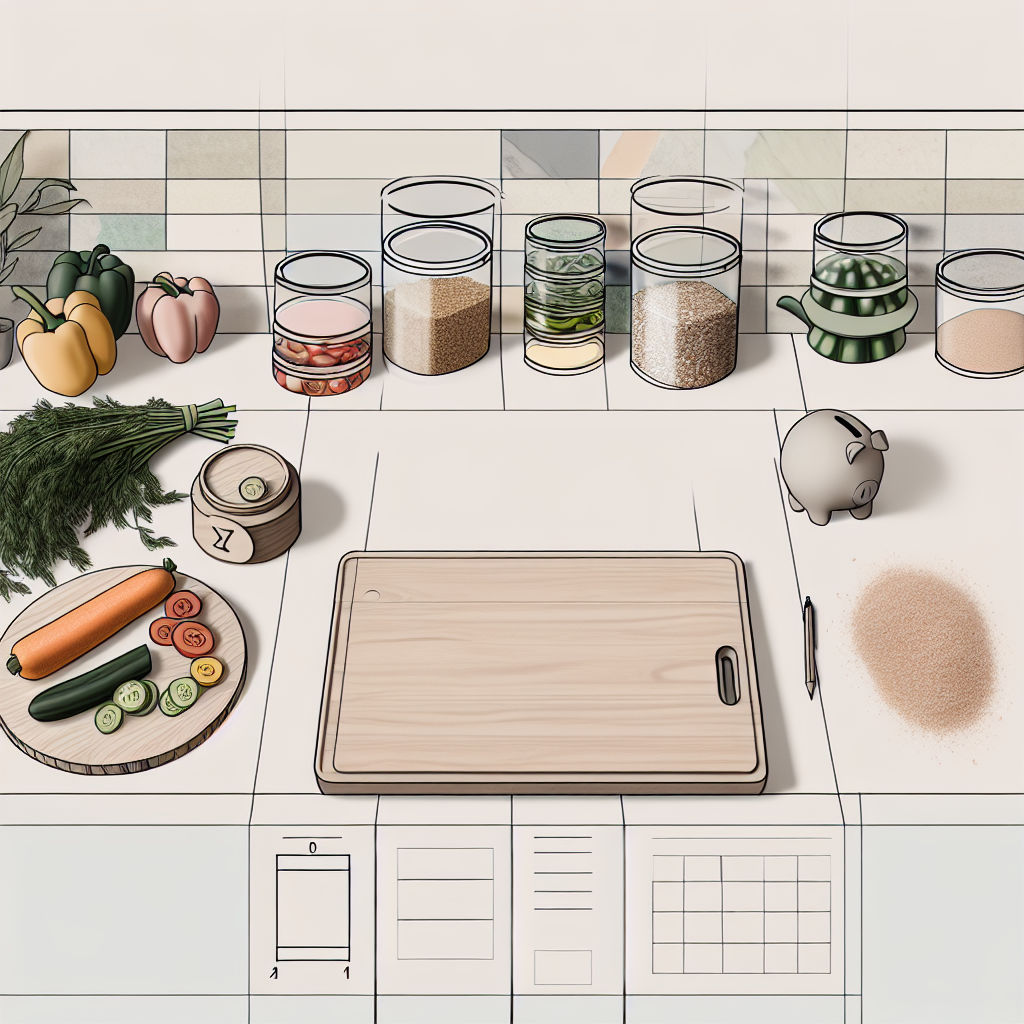Want to save money, reduce waste, and streamline your meal prep business? Ingredient cross-utilization is the answer. This approach involves using the same ingredients across multiple dishes to improve efficiency and cut costs without sacrificing quality. Here's what you'll learn:
- What is ingredient cross-utilization? A method for reusing ingredients like roasted sweet potatoes across salads, curries, and sides.
- Why it matters: Boosts profit margins by 2-3%, reduces food waste by up to 30%, and simplifies inventory management.
- Key strategies: Choose multi-purpose ingredients (e.g., quinoa, chickpeas), create versatile sauces, and plan modular menus.
- Tools to help: Use software like Eat Fresh Tech for menu planning, inventory tracking, and recipe scaling.
- Real results: Businesses using this strategy save 2-5% on food costs and improve kitchen efficiency by 25%.
This guide will show you how to implement cross-utilization in your kitchen with practical tips, examples, and tools.
Why You Should Meal Prep Like A Restaurant
Choosing Multi-Purpose Ingredients
To get the most out of your ingredients and keep costs in check, it's smart to focus on items that can be used in a variety of dishes without losing their flavor or quality. Picking ingredients that work well across different cuisines and cooking methods is key to efficient menu planning.
Here's a quick look at some versatile ingredients and how they can be used:
| Ingredient | Common Uses | Additional Ideas |
|---|---|---|
| Quinoa | Bowl base, Side dish | Salad topping, Breakfast porridge |
| Sweet Potatoes | Roasted sides, Mash | Veggie burger mix, Curry filler |
| Bell Peppers | Raw in salads | Roasted for fajitas, Stir-fries |
| Greek Yogurt | Protein source | Sauce base, Dip ingredient |
| Chickpeas | Salad topping | Roasted snack, Hummus |
When choosing these base ingredients, think about how flexible they are. Ingredients that work in multiple ways can help you keep your menu exciting while simplifying your kitchen operations.
Sauce and Seasoning Applications
Another way to stretch your ingredients is by using sauces and seasonings that work across different dishes while keeping the flavors distinct.
Tips for Creating Multi-Use Sauces and Seasonings:
- Start with base sauces that you can tweak for various cuisines.
- Develop spice blends that pair well with a range of proteins.
- Use marinades that work for both meats and veggies.
For example, a cilantro-lime dressing can double as a salad dressing, marinade, or dipping sauce [1].
Similarly, base sauces like tomato sauce can be transformed into marinara, enchilada sauce, or even a curry base just by adjusting the spices. This approach not only saves time but also boosts ingredient efficiency.
Menu Planning for Ingredient Reuse
Strategic menu planning takes multi-purpose ingredients to the next level, ensuring they're reused effectively across dishes while keeping the menu diverse and appealing.
Building Mix-and-Match Menu Components
One of the smartest ways to reuse ingredients is by creating modular menu components that can be combined in different ways. This method is a hit with customers - 78% of meal prep subscribers prefer menus that offer mix-and-match options[4]. For example, a meal prep service managed to cut food waste by 25% and reduce food costs by 18% by using a single batch of grilled chicken in five different dishes. Bonus? They saved 3 hours of daily prep time.
This modular system works perfectly with the sauce and seasoning strategies mentioned earlier:
| Component Type | Base Options | Preparations | Usage Examples |
|---|---|---|---|
| Proteins | Chicken, Tofu, Beef | Grilled, Roasted, Braised | Main dish, Salad topping, Bowl protein |
| Bases | Quinoa, Rice, Greens | Steamed, Raw, Seasoned | Bowl foundation, Side dish, Salad base |
| Vegetables | Broccoli, Peppers, Carrots | Roasted, Sautéed, Raw | Side dish, Bowl component, Garnish |
| Sauces | Teriyaki, Pesto, Curry | Fresh, Heated, Mixed | Protein coating, Dressing, Flavor boost |
Smart Menu Rotation and Ingredient Efficiency
A well-thought-out menu rotation keeps things fresh for customers while maintaining operational efficiency. Using 2-4 week cycles allows you to introduce new dishes without disrupting ingredient consistency[1].
How to optimize your rotation:
- Theme-Based Planning: Use weekly themes to repurpose base ingredients in creative ways. For instance, turn chicken breast into Mediterranean, Asian, and Mexican dishes by simply changing the seasonings.
- Seasonal Tweaks: Incorporate seasonal produce into your rotation while sticking to core proteins and grains.
The "cook once, eat twice" method can save up to 4 hours of prep time each week[7].
Software Tools for Ingredient Management
Managing ingredients efficiently is key for meal prep businesses, and software tools can make this process much smoother. Here's how these tools help bridge the gap between planning and execution.
Eat Fresh Tech: Platform Features

Eat Fresh Tech provides tools tailored for meal prep businesses, making it easier to reuse ingredients across dishes. The platform includes features like a rotating menu creator that automatically identifies ingredient reuse opportunities, along with a robust ingredient management system. Here's a breakdown:
| Feature | How It Helps |
|---|---|
| Rotating Menu Creator | Matches ingredients across weekly menus. |
| Custom Meal Builder | Tracks ingredient usage as meals are created. |
| Allergen Tracking | Ensures safe ingredient use for dietary restrictions. |
| Recipe Scaling | Adjusts portions while maximizing ingredient usage. |
The software also provides detailed reports on ingredient usage, helping businesses spot opportunities to reuse ingredients more effectively.
Digital Inventory Control
Inventory management software takes ingredient tracking to the next level by offering tools that streamline operations. These features are particularly useful:
| Feature | What It Does |
|---|---|
| Real-Time Tracking | Keeps tabs on ingredient levels across recipes. |
| Automated Alerts | Warns staff about low stock or potential waste. |
| Usage Analytics | Highlights trends for smarter ingredient reuse. |
| Freshness-First Rotation | Ensures ingredients are used in the right order. |
With real-time tracking, businesses can avoid overordering and reduce waste. Automated alerts keep staff informed, while analytics uncover better reuse strategies. Integration with inventory systems ensures that purchases align with cross-utilization plans.
These tools address common challenges and help businesses streamline ingredient management for better efficiency.
Solving Cross-Utilization Problems
Effectively managing ingredient cross-utilization means tackling common challenges while ensuring meals remain diverse and high-quality. It's no wonder that 72% of successful meal prep services pair cross-utilization strategies with the digital tools mentioned earlier [1].
Keeping Dishes Distinct
One of the biggest hurdles in cross-utilization is avoiding repetitive flavors when using the same ingredients across different dishes. According to the National Restaurant Association, 62% of meal prep services find it challenging to create distinct flavors with shared ingredients [1].
Here's how some businesses keep their dishes unique:
| Technique | Application | Impact |
|---|---|---|
| Varied Cooking Methods | Preparing the same ingredient in different ways (e.g., grilling, roasting, poaching) | Adds diverse textures and flavors |
| Global Flavor Profiles | Using different seasoning blends for shared ingredients | Broadens menu options |
"Our braised beef functions as both taco filling and ramen topping through strategic seasoning adjustments" [2].
One meal prep service reported a 30% boost in customer satisfaction by rotating core ingredients weekly [3].
Staff Training for Cross-Utilization
Successful cross-utilization isn't just about tools - it also depends on skilled staff. Training your team is critical for smooth execution.
"Create a cross-utilization matrix for your menu items and conduct hands-on training sessions where staff can practice creating multiple dishes from the same set of ingredients. This approach improved our kitchen efficiency by 25% and reduced food waste by 15%" [5].
Key training areas include:
| Training Focus | Purpose | Outcome |
|---|---|---|
| Ingredient Knowledge | Understanding versatility and shelf life | Improved inventory management |
| Multi-use Prep Techniques | Learning efficient preparation methods | More creative dish combinations |
| Quality Control | Ensuring consistency across dishes | Supports bulk purchasing benefits |
| Storage Techniques | Preserving ingredient freshness | Reduced waste |
Regular taste tests can help ensure that cross-utilized ingredients deliver the right flavors in every dish. This approach not only enhances menu appeal but also contributes to the 2-5% cost savings mentioned earlier.
Steps to Better Ingredient Usage
Now that we've covered staff training and the role of technology, let's pull together the key steps for making ingredient cross-utilization work effectively.
Key Takeaways
Using ingredients more efficiently can lead to real savings. For example, Freshly's 2022 chicken program cut waste by 22% and saved $1.2 million annually by rethinking how ingredients were used.
By combining the training methods we discussed earlier with a clear strategy and the right digital tools, you can see similar results.
How to Get Started
Here's a simple action plan for meal prep services to roll out a cross-utilization strategy:
- Audit 5-10 commonly used ingredients
Start by identifying versatile ingredients already in heavy rotation. According to LeanPath, 76% of commercial kitchens saw better profitability within six months of applying structured cross-utilization practices [6]. - Create a cross-utilization matrix
Use this tool to map out how each ingredient can be used across multiple dishes. Inventory software can help uncover patterns and highlight areas to streamline. - Adopt inventory tracking and recipe scaling tools
Leverage the digital tools mentioned earlier to monitor ingredient usage and adjust recipes efficiently."The integration of digital inventory management systems with cross-utilization strategies has become a game-changer for meal prep operations, leading to an average 4-7% reduction in overall food costs while maintaining menu diversity" [3].
Finally, regularly review your metrics using platforms like Eat Fresh Tech to keep improving over time.
FAQs
What is cross-utilization of ingredients?
Cross-utilization is when meal prep businesses use a single ingredient in multiple dishes. For instance, grilled chicken can be added as a protein for salads, used as a filling for wraps, or included in bowls.
What is the process of cross-utilization in the kitchen?
Cross-utilization involves planning how ingredients can work across various menu items. Here's how it works:
| Step | Action | Result |
|---|---|---|
| Menu Review | Look at recipes to find shared ingredients | Identifies where ingredients can be used in multiple dishes |
| Bulk Cooking | Prepare versatile base ingredients in large quantities | Ensures consistency and saves time |
| Organized Storage | Use a first-in, first-out system with clear labeling | Keeps ingredients fresh and reduces waste |
| Standardized Recipes | Develop recipes that outline multiple uses for ingredients | Keeps dishes consistent and easy to replicate |
Using these steps along with inventory tracking tools (as covered earlier) can make your kitchen more efficient.
What is an example of cross-utilization?
Gramercy Tavern in New York City is a great example. They used clams in both their Seafood Tower appetizer and seabass entrée [4]. Another example is chickpeas - they can be tossed in salads, blended into hummus, or roasted for snacks. This approach ties into the modular component strategy mentioned in menu planning.


